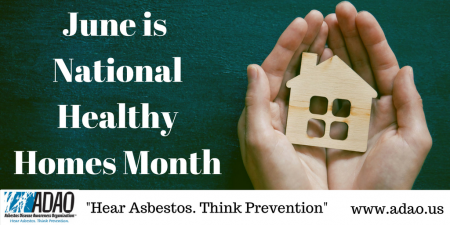*We’ll be posting featured Healthy Homes content from our Prevention Advisory Board health and safety experts throughout the month — keep an eye out!
Posted on June 12, 2017
 June 2017 is the 2nd annual National Healthy Homes Month (NHHM), led by the Department of Housing and Urban Development (HUD). According to HUD, “This month-long celebration offers an opportunity to learn more about housing and its impact on health and provide resources to encourage local activities as well as empower families to protect themselves from hazards in their home.”
June 2017 is the 2nd annual National Healthy Homes Month (NHHM), led by the Department of Housing and Urban Development (HUD). According to HUD, “This month-long celebration offers an opportunity to learn more about housing and its impact on health and provide resources to encourage local activities as well as empower families to protect themselves from hazards in their home.”
While we at the Asbestos Disease Awareness Organization (ADAO) applaud this effort at increasing holistic wellbeing, we were distressed to find that the NHHM agenda and materials mentions nothing about identifying and managing asbestos risk in homes! Given that asbestos is a known carcinogen that was heavily used in construction for decades, this seems like a pretty severe oversight. But have no fear, ADAO is here, contributing to NHHM this quick guide on protecting yourself from at-home asbestos exposure.
-
-
Learn Your Risk
Download our one-page flyer about identifying asbestos in your home: “Identifying Asbestos in Your Home”
Asbestos has been used in many products found in the home to provide insulation, strength, and fire protection. In 1989, the U.S. Environmental Protection Agency (U.S. EPA) announced a phased ban of asbestos products to be completed by 1996. The most common items in the home that may contain asbestos are:
- Vinyl flooring
- Duct wrapping on heating and air conditioning systems
- Insulation on hot water pipes and boilers, especially in homes built from 1920 to 1972
- Some roofing, shingles, and siding
- Ceiling and wall insulation in some homes built or remodeled between 1945 and 1978
- Sheet rock taping compounds and some ceiling materials
- Asbestos that has been sprayed on ceilings often has a spongy, “cottage cheese” appearance with irregular soft surfaces. The manufacturers can provide information on the asbestos content of home products. A Certified Asbestos Consultant can be hired to determine whether or not asbestos is present and to give advice about how to take care of it safely.
-
Don’t Touch!
Asbestos is a human carcinogen that kills as many as 15,000 Americans every year. Asbestos-containing materials may release fibers when they are disturbed, damaged, removed improperly, repaired, cut, torn, sanded, sawed, drilled or scraped.
-
Get Tested
When asbestos is suspected of being present in building materials, it is important to have the materials tested by a qualified laboratory. Visual inspection alone is not enough to identify the presence of asbestos. However, such testing may not be warranted if the material is in good condition, in which case it is best to leave it in place. If the material is damaged, or will be disturbed during normal household activities or remodeling, it should be tested.
Click here to find accredited asbestos professionals in your area:
State Asbestos Contacts | Asbestos | US EPA http://bit.ly/2r2AICI -
“Hear Asbestos. Think Prevention.”
Follow EPA Asbestos Dos and Don’ts for the Homeowner:
- Do leave undamaged asbestos-containing materials alone.
- Do keep activities to a minimum in any areas having damaged material that may contain asbestos, including limiting children’s access to any materials that may contain asbestos.
- Do take every precaution to avoid damaging asbestos-containing material.
- Do have removal and major repair done by people trained and qualified in handling asbestos. It is highly recommended that sampling and minor repair also be done by a trained and accredited asbestos professional.
- Don’t dust, sweep, or vacuum debris that may contain asbestos.
- Don’t saw, sand, scrape, or drill holes in asbestos-containing materials.
- Don’t use abrasive pads or brushes on power strippers to strip wax from asbestos flooring. Never use a power stripper on flooring that may contain asbestos.
- Don’t sand or try to level asbestos flooring or its backing. When asbestos flooring needs replacing install new floor covering over it, if possible.
- Don’t track material that could contain asbestos through the house. If you cannot avoid walking through the area, have it cleaned with a wet mop. If the material is from a damaged area or if a large area must be cleaned, call an asbestos professional.
-
We’re also taking advantage of Healthy Homes Month by highlighting some new content from health and safety professionals from ADAO’s Prevention Advisory Board. Keep an eye out throughout the month for expert tips and strategies for keeping your home asbestos-free and as healthy as possible!
Together, we are making the world a safer — and healthier — place!
Linda
Social Networks
